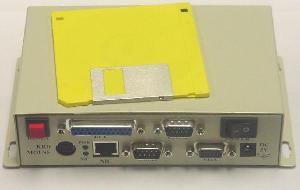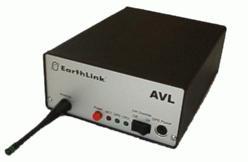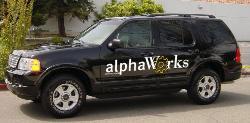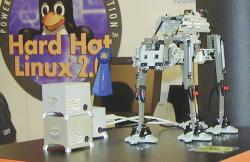
Rick gives his impressions of all things embedded andembeddable at August's mega-Linux event.
Despite the somewhat subdued mood of this year's big West Coast LinuxWorld, there was near-universal agreement that one thing seemed to have grown stronger over the past six to twelve months: embedded Linux. Although the event does not particularly focus on the embedded market, a host of new products, technologies and strategies catering to the needs of embedded systems and smart device developers and manufacturers was unveiled and showcased. Everywhere you turned, you ran across companies embedding Linux inside PDAs, entertainment devices (especially TV set-top boxes), automotive telematics systems, thin clients, etc.
In the past, embedded Linux products and technologies accounted for roughly 10% of what was showcased at LinuxWorld. At this show, the embedded Linux fraction seems to have increased to around 15-20%, which is not surprising, given the strong growth in developer interest in embedded Linux reported in recent months by market analysts VDC, Evans Data Corporation, Embedded Systems Programming magazine, LinuxDevices.com and others.
For those unable to make it to the show, or whose attention was elsewhere, here's my traditional walk on the embedded side of LinuxWorld in which I offer a summary of all things embedded and embeddable (in alphabetic order). My apologies in advance, to anyone or anything I missed.
Visitors to ADS' booth were treated to a dazzling array of LCD-adorned StrongARM-based, single-board computers—truly a hardware geek's paradise. ADS has created their own embedded Linux implementations that are offered as an option with all of their SBCs, but in addition ADS was showcasing three Java-enabled, graphically oriented application environments: Insignia's Jeode VM running on Lineo's Embedix, IBM's VisualAge Micro Edition running on MontaVista's Hard Hat Linux and Blackdown's JDK running on ADS' own flavor of embedded Linux. ADS also announced this week that they have been selected by Intel as a third-party platform provider for Intel's StrongARM and XScale processors and will be developing a modified version of their Graphics Master SBC for use as a reference platform by Intel customers. (See www.applieddata.net.)
Tucked away at the Linux Terminal Server Project (LTSP) booth, David Anders was showing off his company's tiny Linux system—definitely a cool little Linux box. Anders said a new version, which is coming out soon, adds a CompactFlash slot that facilitates system expansion and the use of removable media. Nice touch. (See www.abcsinc.com.)

A Tiny Linux System from Advantage Business Computer Systems
Century occupied their usual position at a pedestal within Red Hat's large pavilion. Century's big announcement at the show was PIXIL, a respin and enhancement of its previous key products (Microwindows and ViewML) into a new suite of graphical environments, tools and applications targeting Linux-based PDAs, webpads and thin-client devices. Demonstrations included PIXIL running on a Compaq iPAQ PDA, as well as a PIXIL-based set-top box based on National Semiconductor's SP1SC10 set-top box development platform. Greg Haerr (Century's CEO) made the claim that, whereas the TV Linux Alliance Project is just at the point of beginning to define standards, Century/National's newly announced Linux4.TV is available for immediate use by customers and already provides support for both digital and analog TV, personal video recorder (PVR) functions and APIs for both kernel and middleware software interfacing. (See embedded.censoft.com.)
CodeWeavers demonstrated the recently announced CrossOver technology that allows Linux systems to use Windows browsers and application helpers. According to Jeremy White (president), an embedded version of CrossOver is being developed that will occupy on the order of 1MB of RAM and 4.5MB of storage. Unfortunately, the Windows plugins are sometimes quite greedy in terms of the system resources they require in order to run under CrossOver. CodeWeavers, a driving force behind WINE, can provide services for getting embedded applications to run on Linux under WINE or can port the apps directly to Linux APIs. (See www.codeweavers.com.)
This group showcased the prototype of an open-standards Automotive Vehicle Location (AVL) telematics platform that was created to serve as a platform to demonstrate automotive software applications, study how Linux and internet technologies can be applied to the automotive environment and test the feasibility and effectiveness of systems such as remote diagnostics, m-commerce and location-sensitive applications. Earthlink is sponsoring a contest for Linux, XML, Java, wireless and web application developers. Come up with a clever idea and get one of these interesting systems to play with. (See www.research.earthlink.net.)

Earthlink R&D's Telematics Research Platform Runs Linux
The ELC announced that several new members have joined recently, including Future Sound Technologies, Intel Corporation, American Megatrends, Inc., Aleph One, Ltd. and Vibren Technologies. Based on the roster at the ELC web site, the consortium currently has 68 corporate members (36 executive and 32 affiliate level). One bit of hot news is that the ELC's Board of Directors recently approved a change to the ELC's bylaws to allow the ELC to own intellectual property, thereby clearing the way for ELC to engage in developing and licensing embedded Linux standards. (See www.embedded-linux.org.)
On the opening day of LinuxWorld, ELJ announced the winners of their first embedded Linux design contest. Each winner gets an all expenses-paid trip to Costa Rica! (See embedded.linuxjournal.com.)
Empower demonstrated their new LinuxDA “Linux upgrade” for the Palm III and V. They also announced that LinuxDA has been licensed by two Palm-compatible Taiwanese consumer device manufacturers: Elitegoup Computer Systems and APlux Communications. (See linuxda.com.)
Hewlett-Packard issued a major embedded Linux strategy announcement in connection with LinuxWorld. Per the announcement, embedded Linux is now the OS of choice for all HP-developed devices. HP's embedded Linux system is called Chai-LX. HP also demonstrated the new Digital Entertainment Center audio system, which contains an x86 processor and uses Chai-LX as its embedded OS. (See www.hp.com/linux.)

Linux in the Living Room? HP's New Digital Entertainment Center
IBM alphaWorks showed off its experimental TechMobile, a modified Ford Explorer 2002 Limited Edition that has been outfitted with Linux-powered computers running a variety of web-enabled applications. In the demo, a simple user interface on a Bluetooth-enabled PDA controls the car's headlights, door locks and engine starter. Other IBM technologies showcased in various locations on the show floor with applicability to embedded Linux-based systems included the DB2 database, VisualAge Micro Edition (shown by MontaVista) and Embedded ViaVoice (also at MontaVista's booth). (See www.alphaworks.ibm.com.)

IBM's Car of the Future Has “Linux Inside”
In contrast with last summer, when Lineo occupied multiple locations on the show floor due to having acquired several other Embedded Linux companies, Lineo was not an exhibitor this time, but instead held a press conference to make several strategic announcements. These included: the selection of Lineo's Embedix Digital Media core by Motorola for use in the DCT5000 set-top box and the planned release of a “GPL Compliance Toolset” to help developers and their companies identify which licenses govern their software and what the implications of those licenses are. (See www.lineo.com.)
If you ask Compaq when (or where) you can get an iPAQ with Linux pre-installed, they'll probably refer you to Lisa Systems. Lisa demonstrated their iPAQ/Linux combo, which makes use of Trolltech's Qt/Embedded as its GUI framework, at a pedestal in Compaq's large LinuxWorld pavilion. (See www.lisa.de.)
Like Lineo, LynuxWorks decided not to have their own booth at LinuxWorld. They did, however, have a small presence at a pedestal within Intel's pavilion, where they demonstrated their port of BlueCat Linux to Intel's Internet Exchange Architecture (IXA). (See www.lynuxworks.com.)
Like a show within a show, MontaVista's large pavilion-style booth was bristling with product and technology demonstrations. Beneath a giant hard hat-adorned Tux suspended from the convention hall ceiling, were:
A demo of Hard Hat Linux (HHL) 2.0's cross-development tools targeting an Alchemy AU1000 system-on-chip based set-top box reference platform. The use of the new KDevelop IDE was also being shown, as were MontaVista's Target Configuration Tool and newly GPLed Library Optimizer Tool.
A demo that dramatized the improvement in interrupt latency that can be obtained using MontaVista's “fully preemptable kernel” enhancement, in which streaming audio was being played in a system that was under a heavy load (repeated disk saves). Interrupt latencies were captured and graphed for visual comparison.
A demo of MontaVista's newly announced High Availability Framework, in which a CompactPCI-based Linux system was shown to maintain a video display reliably from a network-based streaming video source while one or more of three Ethernet cables were disconnected.
A set-top box demo based on HHL and the recently announced Hard Hat Graphics running on IBM's “Redwood” PowerPC 405-based reference platform.
HHL running on an iPAQ PDA, using two approaches—Hard Hat Graphics and Trolltech's Qt/Embedded—including demonstrations of both tools' GUI-builder development methods.
Demos of two IBM products: VisualAge Micro Edition, a Java-like VM; and ViaVoice, speech recognition software that supports both desktop and embedded systems. ViaVoice-based speaker-independent command and control supposedly can fit within 200KB of RAM.
A delightful demonstration of embedded Linux-based machine control, in which Intrinsyc's tiny StrongARM-based CerfBoard SBC running HHL was shown controlling the walking of a Lego MindStorm Robot that looked like something out of a Star Wars movie. (See www.mvista.com.)

Look What a Tiny StrongARM SBC Plus Embedded Linux Can Do
PalmPalm showed off their Tynux Box StrongARM-based PDA reference platform and Tynux Linux OS. They also had a Korean-manufactured cell phone/PDA on display. (See www.palmpalm.com.)
Joe deBlaquiere (senior engineer) demonstrated a prerelease version of a new Red Hat Embedded Linux Developer Kit. The tool is meant to make it easy for developers to embed Red Hat Linux. According to deBlaquiere, the tool makes use of standard Red Hat SRPMS, so it “leverages the stability of Red Hat Linux transitioned to the embedded space”. A number of predefined baseline configurations are available, including minimum bootable system, minimum networked system, etc., to which developers can add whatever they require by means of an easy-to-use, GUI-based configurator. One unique aspect to Red Hat's target OS builder approach, according to deBlaquiere, is that unlike Lineo's LIPO and MontaVista's LOT, Red Hat's library reduction/optimization process makes use of the four defined EL/IX profiles, with the result that embedded systems will be characterizable as being compliant with a specific well-defined API set. Additionally, Red Hat's RedBoot debugger/boot loader has been integrated into the new Embedded Linux kit as a standard component. deBlaquiere said the first beta release of the new kit is expected within a few weeks. Speaking of which, both RedBoot and Red Hat's other OS, eCOS, were also being demonstrated in Red Hat's pavilion. (See www.redhat.com/embedded.)
REDSonic demonstrated four new products, including: Secure SOHO, a gateway/firewall software solution; Windows-Based Terminal, software that provides thin-client, Linux-based access to Windows applications and services; LinuxBIOS, a ROM-based Linux kernel that replaces legacy BIOS code for secure, fast boot; and a REDSonic PowerPC starter kit for the MPC 823. REDSonic also showcased an interesting customer application: SignSite, manufactured by Clarity Visual Systems. It is a bright, full-color “digital billboard” that is used for advertising and information display in public places. The device contains an embedded Ampro Encore 500 Pentium-based SBC running REDSonic's REDICE-Linux OS. (See www.redsonic.com.)
RidgeRun demonstrated DSPLinux running on TI's digital still camera reference platform based on the TI TMS320DSC21 dual-core (RISC + DSP) system-on-chip processor. That chip, according to Rudy Prince (RidgeRun CEO), is used in several high-end digital cameras from HP and Kodak. Also demonstrated was the DSPLinux development environment's very slick “appliance simulator”. Can we expect to find DSPLinux inside digital cameras sometime soon? “Yes”, replied Prince. Embedded Linux will play a growing role in devices that feature Ethernet, 802.11 or Bluetooth connectivity and other high-end functions, according to Prince. (See www.ridgerun.com.)
While passing by the Japan Linux Association's booth in the .org area, I noticed some demos of Linux running on two Japan-manufactured game machines: Sony's PlayStation 2 and Sega's Dreamcast—the former, based on Sony's recently released PS2 SDK, and the latter, based on efforts of the Linux-SH Project.
Tuxia demonstrated their TASTE Embedded Linux running on a new set-top box reference platform and also on some very nice looking thin-client systems. They also gave the first LinuxWorld demonstration of their TASTE OS running on an iPAQ PDA. The iPAQ demo included TUXIA's Nanozilla small footprint browser with 802.11 wireless web connectivity. The company issued two key news announcements in conjunction with the show: an agreement with system-on-chip maker Rise to support Rise's SOCs with TASTE Embedded Linux and the selection of TASTE as the Embedded Linux OS for a new consumer media gateway reference platform being developed by Intel. (See www.tuxia.com.)
TVT was showing TV set-top box and PDA applications for its new Java/XML/Linux based XOE architecture. (See www.transvirtual.com.)
Trolltech demonstrated a prerelease of version 2 of the Qt Palmtop environment, running on the ubiquitous iPAQ PDA. According to Aron Kozak (Trolltech's PR manager), the environment also works on Sharp's Zaurus PDA. New functions being demonstrated included synchronization, a multiplatform desktop PIM suite, improved add/remove software features, an enhanced GUI design and several new applications including an e-mail client. According to Trolltech's announcement, the full release of version 2 will have features designed to support not just PDAs, but also next-generation “smart phones”. A downloadable beta release is expected in October 2001. Incidentally, Trolltech won LinuxWorld's coveted “Best Embedded Linux Solutions” award for Qt/Embedded at the show. (See www.trolltech.com.)
Empower Technologies has announced a $99 PDA that the company claims is a Palm IIIxe clone from the hardware perspective, but runs Empower's Linux DA operating system instead of Palm OS. Here's a summary of specs, according to information on the company's web site:
Palm IIIxe-compatible
Supplied with Linux DA O/S for PowerPlay III
Screen: 240 x 320 pixels, monochrome touchscreen
Processor: Motorola Dragonball, 16MHz clock rate
8MB RAM
2MB Flash (upgradeable)
Serial port for connection to PC
Expansion slot(s): none
Battery: nonrechargeable AAA cells
Color available: Galaxy Grey
15 days technical support by e-mail
Six-month Linux DA O/S software upgrade
One-year warranty
Includes: carrying case, two AAA batteries, PC Sync Cable, CD with PC Sync
Program, Quick-Start Manual, Handwriting Guide, Warranty Card, Registration Card
(See www.empowertechnologies.com.)
Rick Lehrbaum (rick@linuxdevices.com) created the LinuxDevices.com “embedded Linux portal”. Rick has worked in the field of embedded systems since 1979. He cofounded Ampro Computers, founded the PC/104 Consortium and was instrumental in creating and launching the Embedded Linux Consortium.